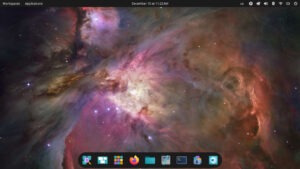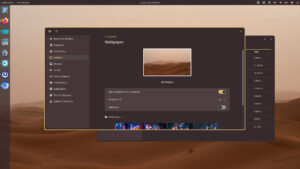Unless you’re a motorhead to a varying degree — and an older one at that — you probably don’t know who John Cooper is. His contributions in racing circles — putting the engine behind the driver in his Cooper racing cars in the 1950s — would normally cement his place in automotive history, but he didn’t stop there.
The thing for which Cooper is more widely known is modifying the British Motor Corporation’s Mini in the 1960s, adding his name to make it the Mini Cooper while adding a higher degree of performance that won the little-car-that-could a warehouse full of rally trophies and Sports Car Club of America club racing victories.
[Arguably, there’s something to be said about the unique similarities in comparing the now-bloated Mini now made by BMW to the Mini Coopers of the ’60s with comparing distros of the past and now — but we won’t go there today.]

Photo by Lars-Göran Lindgren Sweden – Own work. Licensed under CC BY-SA 3.0
So go ahead and ask: “What the heck does this have to do with Linux and FOSS?”
Simple. Linux and FOSS have a wide cast of Coopers and Shelbys making high performance versions of mass-produced distros, building on the foundation of one of the “big three” Linux distros to make fire-breathing, pixel-burning distros; distros that are the digital equivalent of vehicles that are more than just for taking the kids to soccer practice or zipping over to the grocery store.
In fact, many of the less-than-mainstream distros out there — most of the nearly 300 Linux and BSD distros, as a matter of fact — are more than just a developer “scratching an itch.” In many cases, it’s a matter of chopping and channeling, boring out the engine, adding high performance parts, aerodynamic devices like spoilers and air dams, and even painting a flame or two on the side.
Not everyone can drive a Cobra or a Testarossa, nor does everyone want to. But knowing that the option is there, and that there are people out there providing high-performance options, is one of FOSS’s strengths.
We see this in distros like Korora, where Ian Firns and Chris Smart and his team once based their distro on Gentoo and switched “manufacturers” to use Fedora in producing a solid, quick distro that works well, and Internet-ready, right out of the box.
Jeff Hoogland and his band of developers at Bodhi Linux marry the lightweight Enlightenment desktop environment to Ubuntu. A combination of the lightweight desktop and the users’ choice of what to include in their own digital vehicle makes this perhaps the best combination of getting the best performance out of one’s machine.
Pixel-burning performance was one of the hallmarks at CrunchBang, until Philip Newborough stopped development on his distro which had the Openbox-based window manager with Debian rumbling under the hood. A successor distro is now in the proverbial garage under the banner of BunsenLabs and — with a release candidate ready from the same Crunchbang blueprints — it will be out on the track soon enough.
Examples are abundant, and forgive me if I don’t get to all of them. There are others which deserve mention, and you’re welcome to add your favorites in the comments section.
So when someone complains about the fact that there are nearly 300 distros out there, bear in mind many of them are not for everyone.
So buckle up, and let’s be careful out there.







When someone complains about too many distros: It’s a pretty clear sign they don’t know what they’re talking about.
300+ distros, reminds me of a Windows Application http://www.linuxliveusb.com that will FTP download and burn/write to USB Flash drive a linux distro of your choice. (1 among 350 versions)
http://rufus.akeo.ie another single file, rufus.exe to write/burn a .ISO file into a usb flash drive.
http://puppylinux.org or Ibiblio.org download site for puppylinux. http://distro.ibiblio.org/puppylinux/puppy-tahr/iso/tahrpup%20-6.0-CE/ Look for Tahrpup 6.0.2 NOPAE .ISO file to download. 10 minutes, 2 downloads, 1 USB Flash Drive Enjoy using your computer again!
One thing I don’t get
what should be used on Linux yum, sudo or app get…
I actually like the comparison between Linux and car engines, the fact that there are those for everyone, and those for people who like to get the max performance, or who like working with the internals of the system. I mostly use Ubuntu as my distro at home to make it simple and reliable, but I like hacking and playing with strange distros from time to time on the RPi or other small devices.
“One thing I don’t get
what should be used on Linux yum, sudo or app get…”
Well.
“Not everyone can drive a Cobra or a Testarossa,”
yum is for rpm command structure to install packages
apt is for debian command structure to install packages
sudo is explained in wikipedia as well as apt and yum.
I am just a illerterate linux using biker who runs linux full time.
Windows assumes and treats me like a idiot.
Linux at least demands I prove it.
Just a honorable mention for your article for a revving distro
code:
@biker:~
$ inxi -Fxz
System: Host: biker Kernel: 4.2.1-antix.2-686-pae i686 (32 bit gcc: 4.9.2)
Desktop: IceWM 1.3.8
Distro: antiX-15-V_386-full Killah P 30 June 2015
Machine: System: Dell product: Latitude E4310 v: 0001
Mobo: Dell model: 0T6M8G v: A01 Bios: Dell v: A03 date: 07/08/2010
CPU: Dual core Intel Core i5 M 520 (-HT-MCP-) cache: 3072 KB
flags: (lm nx pae sse sse2 sse3 sse4_1 sse4_2 ssse3 vmx) bmips: 9579
clock speeds: max: 2400 MHz 1: 1199 MHz 2: 1733 MHz 3: 1599 MHz
4: 1333 MHz
Graphics: Card: Intel Core Processor Integrated Graphics Controller
bus-ID: 00:02.0
Display Server: X.Org 1.16.4 drivers: intel (unloaded: fbdev,vesa)
Resolution: 1366×768@60.00hz
GLX Renderer: Mesa DRI Intel Ironlake Mobile x86/MMX/SSE2
GLX Version: 2.1 Mesa 10.3.2 Direct Rendering: Yes
Audio: Card Intel 5 Series/3400 Series High Definition Audio
driver: snd_hda_intel bus-ID: 00:1b.0
Sound: Advanced Linux Sound Architecture v: k4.2.1-antix.2-686-pae
Network: Card-1: Intel 82577LM Gigabit Network Connection
driver: e1000e v: 3.2.5-k port: 6040 bus-ID: 00:19.0
IF: eth0 state: down mac:
Card-2: Intel Centrino Advanced-N 6200
driver: iwlwifi bus-ID: 02:00.0
IF: wlan0 state: up mac:
Drives: HDD Total Size: 60.0GB (35.2% used)
ID-1: /dev/sda model: KINGSTON_SV300S3 size: 60.0GB
Partition: ID-1: / size: 7.6G used: 3.7G (52%) fs: ext3 dev: /dev/sda2
ID-2: /home size: 48G used: 16G (36%) fs: ext3 dev: /dev/sda1
Sensors: System Temperatures: cpu: 55.0C mobo: N/A
Fan Speeds (in rpm): cpu: N/A
Info: Processes: 143 Uptime: 1:06 Memory: 615.4/8027.1MB
Init: SysVinit runlevel: 5 Gcc sys: 4.9.2
Client: Shell (bash 4.3.301) inxi: 2.2.28
I equate this distro to a http://cdn.silodrome.com/wp-content/uploads/2013/03/R131-Fighter-Confederate-Motorcycle.jpg
I don’t quite get the comparison between distros and cars. A car is hardware, and the equivalent to software in a car might probably be the payload. But on decent computer hardware, I’ll bet that there are no significant differences in speed between various Linux distros.
Of course, if your computer is the equivalent of the original Morris Mini, you’ll certainly get more mileage out of a lightweight distro where everything is optimized for minimal hardware.
I’m running Gentoo, which once was touted as the ultimate speed trip, on my 5 year old desktop with an i7 Quad and 6 GB RAM. The desktop environment is plain upstream KDE 4. The speed of the distro is, as far as I’m concerned, irrelevant. What is appealing to me, is rather the flexibility and total configurability of the system.